DC Power Sources and Batteries
Every electric circuit needs a power source, and the type of source dictates the functionality of the circuit. A DC power source is a device or system that provides a consistent voltage and is used to power electric circuits. The most common type of DC power source is a battery, like the batteries in laptops and cell phones.
A DC power source contains two terminals that are connected to a circuit in order to supply electric power. It provides a potential difference, or voltage, across these terminals. This potential difference pushes electrons into a circuit on at the negative terminal, also called the anode. Simultaneously, it pulls electrons out of the circuit at the positive terminal, also called the cathode.
All direct current circuits require DC power. This can come in form of a battery, a power supply, or an AC (alternating current) to DC converter. Computers (like laptops) that don’t use dedicated power supplies use ‘AC adapters’ to convert AC power from a wall outlet into DC power. The adapter functions as the DC power source to the laptop.
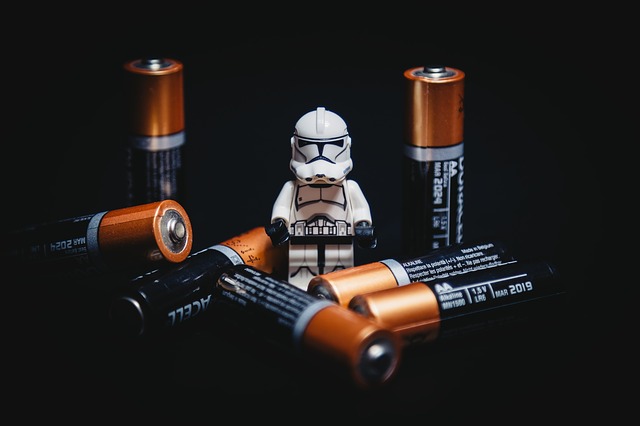
What are DC Power Sources?
Power sources like batteries provide the electrical energy for circuits to function. Anything that uses a battery is relying on a DC power source.
Cell phones, laptops, cars, and cordless appliances like drills or even wine-bottle openers all use batteries as a source of direct current. If a device uses a battery as its’ power source, internally it is comprised of DC circuits.
In fact, any thing that has a computer or digital circuit also relies on DC power sources. As the world becomes more automated and advanced, more devices rely on DC power sources to power the computer chips they use.
A lot of R & D has been invested into making our power sources as useful as possible, so the typical power source does not simply supply or accept electrons randomly; they are designed to do function with as much regularity as possible- without regulating the flow of electricity, it would be really difficult to design devices and tools to use that electricity.
Voltage, Current and Power
By necessity, all power sources involve three interlinked electrical properties: voltage, current, and power.
Although these topics are covered in much greater detail in specific tutorials, it is also useful to cover these topics with regard to power sources.
The primary job of a DC power source is to supply a steady amount of voltage; ideally, a power source would provide a specific voltage with zero fluctuation, forever. For example, an ideal 1.5 volt DC power source would always provide exactly 1.5 volts, forever. In contrast, a real-life 1.5 volt battery actually produces something close to 1.5 volts for most of its’ life, and the voltage decreases as the battery becomes depleted.
Then the terminals of a power source are connected to each other by a wire or a circuit, the voltage produced by the power source results in an electric current that flows through the wire or circuit.
Because the voltage provided by the power source is constant (i.e. it does not change over time), the current produced is also constant. Therefore the type of current that flows in the circuit is direct current. Direct current is an electric current that always flows in the same direction.
In contrast, an alternating current (AC) power source provides an alternating voltage that changes over time like a sine wave. This results in an alternating current that flows back and forth in the circuit.
When current flows through a circuit, the circuit consumes power, which is equal to the voltage supplied by the power source times the current through the circuit:
Power = Voltage x Current
Power tells us how much energy is consumed by the circuit, which makes it an important quantity.
Voltage Sources
In order to create and use reliable circuits, power sources are designed to be as perfect as possible. Most are designed (like batteries) to be a good voltage source; that is, they are designed to keep the voltage that they supply as constant as possible.
Voltage is the difference in electrical potential between two points- the work required to move a specific amount of charged particles between those points. Voltage is responsible for driving the electrons through the circuit.
A voltage source is responsible for generating and maintaining a rated voltage.
For instance, most common alkaline batteries in the US are designed to supply 1.5 Volts. A perfect 1.5 V battery would supply exactly 1.5 Volts to any circuit it was connected to until its’ power ran out. It would supply the same 1.5 V no matter the load, or resistance, in the circuit.
Real-life batteries actually produce a little over 1.5 V when they are new, and the voltage decreases as they are used. Whereas an ideal battery would produce 1.5 V until the moment of complete failure, real batteries slowly produce a lower and lower voltage. Further, the voltage supplied by batteries can vary slightly depending on the circuit being powered by the battery.
Batteries
The most commonly recognized DC voltage source is the electric battery– a device that uses chemical reactions to produce and receive electrons at accessible points that are located for convenience to the designers of our products.
These points are called terminals, which are electrically conductive areas on the outside of batteries, which are connected to the electrochemical cells inside the battery that produce and accept electrons.
The terminal connected to the electron producing cell is called the anode (i.e. the negative terminal), while the terminal connected to the electron accepting cell is called the cathode (i.e. the positive terminal).
Because the anode produces electrons, which are negatively charged, it is also called the negative terminal. The anode is often labelled with a minus (-) sign.
The cathode attracts electrons and is therefore called the positive terminal. The cathode is often labelled with a plus (+) sign.
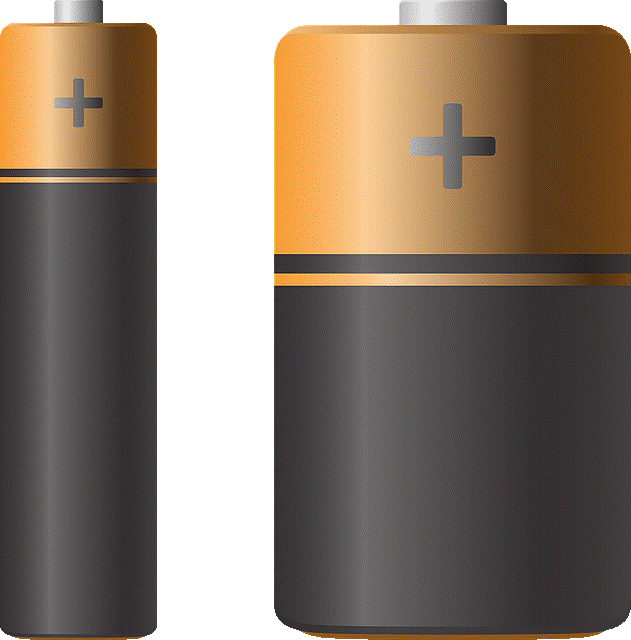
Sometimes you may also hear the two terminals referred to as negative and positive electrodes, but this is not technically correct; the electrode is the conductor inside the battery that connects the terminals to the electrolytic fluid in the electrochemical cell.
Here’s what a DC source (1.5 V battery) would look like in an electrical schematic:
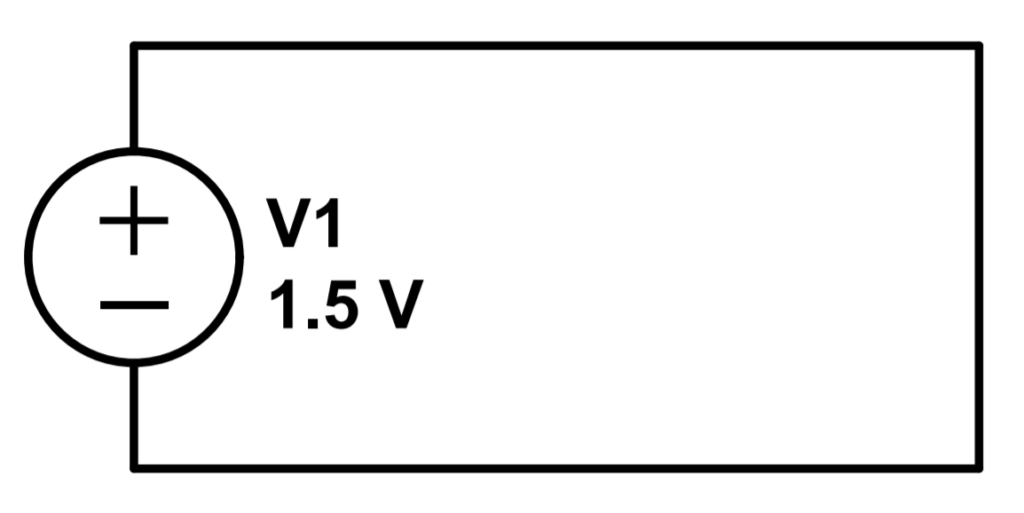
Note that this source is short circuited, or shorted; that is, the negative terminal is directly connected to the positive terminal with little resistance in between. Since there is nothing to reduce the flow of electricity (current), it will flow as much as it possible can; without a resistor, there is nothing to slow the electron flow from the negative terminal to the positive terminal. As we will learn in a later lesson, this would lead to a very high electric current and the battery would quickly fail.
Even more dangerous, the wires or connections themselves might burn out, spark, or start a fire if they are not rated for the high current generated by the short circuit.
In any real application, we will ALWAYS want to place a resistor in series with the battery to prevent a short circuit, as you can see in the schematic below:
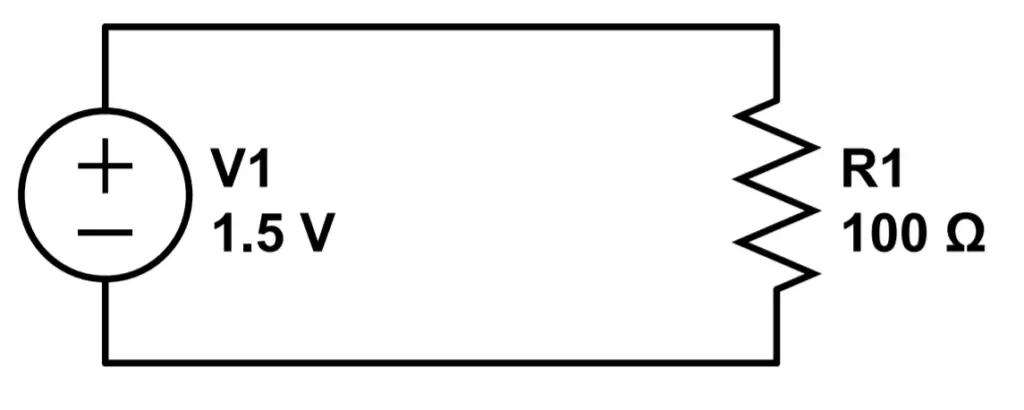
Even a resistor with a small resistance value will prevent a short-circuit.
Battery As a Power Source
Batteries are mobile sources of electric power. We use them to power our phones, computers, and, increasingly, our cars.
You don’t need to understand the electrochemistry of batteries to use them and even to build circuits with them. Batteries are a great power source for circuit prototypes that aren’t designed for AC applications and don’t need to communicate with a computer. Small batteries are safe enough to be used by kids under adult supervision.
Just be aware: even a 9 volt battery can potentially start a fire. That’s why it’s so important to learn theory before or alongside any practical lab work. An experienced electronics enthusiast will know how to avoid potential dangers, so be careful until you get there.
Symbol for DC Power Sources
We’ve seen that batteries are often depicted as a circle with a positive (+) and negative (-) symbol indicating the positive and negative terminals:
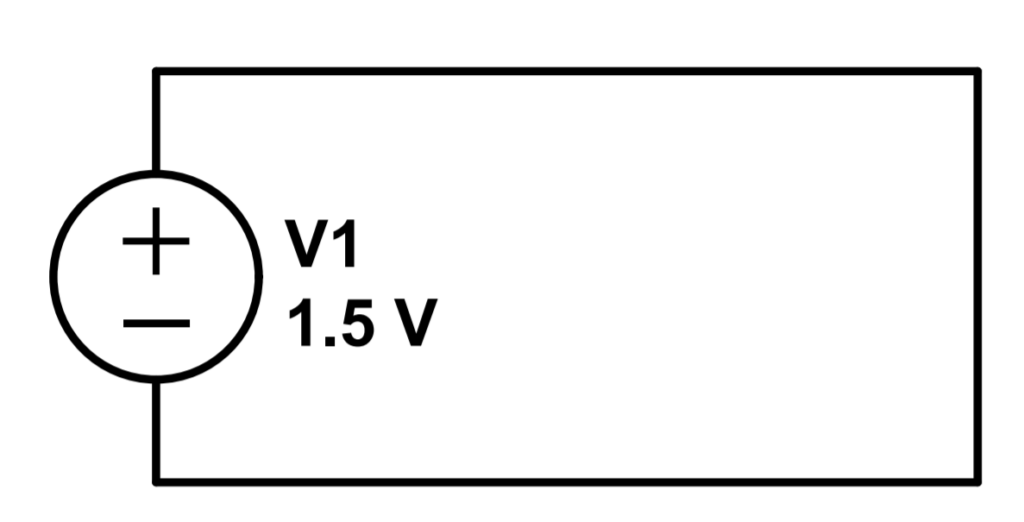
This symbol indicates a generic DC power supply. It could be a battery, it could be a power supply ‘box’ that is plug into a wall outlet to convert AC power of a higher voltage into DC power at a low (1.5 V) voltage.
The ‘+’ symbol at the top of the source indicates that current flows out of the top side. The ‘-‘ symbol at the bottom of the source indicates that current flows into the bottom side. Thanks to Benjamin Franklin, we always define current as moving from positive to negative.
Another common symbol for DC power sources, which is a long line above a shorter line, with the longer line indicating the positive terminal:
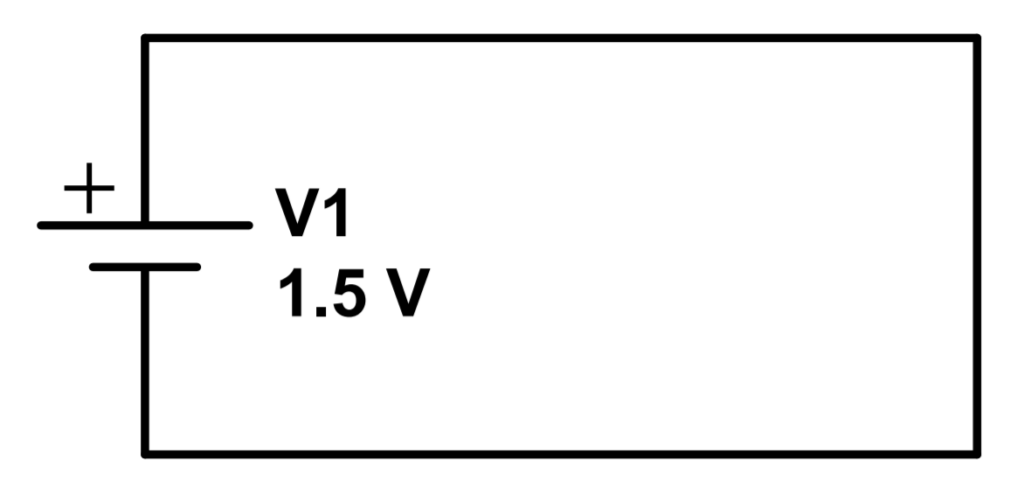
The only difference is the symbol for the source type. In both cases we are using a 1.5 Volt DC voltage source. The second example is that of a single cell battery source. Sources are often shown with a longer bar on top of a shorter bar. The longer bar (on top) indicates the positive terminal, where current flows out of. The shorter bar indicates the negative terminal, where current flows into.
If current flows from the positive terminal to the negative terminal, which way do electrons flow?
Electrons are negatively charged, so they flow from negative to positive. Electron flow is defined as being in the opposite direction of current flow. This is an important thing to keep in mind. In the above circuit, electrons start at the ‘-‘ negative terminal of the voltage source, and work their way towards the ‘+’ positive terminal. The current flows clockwise but the electrons flow counter-clockwise.
Multiple battery symbols can be stacked to show that multiple batteries are being used in series as a voltage source. A multi-cell battery circuit looks like several batteries (symbolized by a long line over a short line) stacked up:

In this case, we have a three cell battery, with each cell contributing 1.5 volts. Each cell is represented by a single ‘long line above short line’ symbol. This voltage source is otherwise identical to the first two examples.
Voltage vs. EMF
Voltage is the potential difference that is supplied by the power source; a 5 volt battery is expected to produce a potential difference of 5 volts across its anode and cathode.
Voltage is the electric potential difference between two points of an electrical network (i.e. two points of a circuit), or more generally, any two points in the universe. Voltage in a DC circuit is always measured with reference to ground, which is usually the anode (negative terminal) of the power source.
Inside the DC voltage source itself, the potential difference must be generated either by a chemical reaction or by conversion from a different type of electrical energy (like an AC outlet). Ultimately, all electrical energy comes from non-electric sources. In batteries, the energy comes from a chemical reaction within the battery. When we plug a device into an AC outlet, we are connecting to a power grid that generates energy from a variety of sources, like AC generators or solar panels.
Therefore, all electric power comes originally from a non-electric source.
The generation of electric power from non-electric sources produces an electromotive force, or EMF. Despite its’ name, EMF is not a force; is measured in volts which is energy per unit of charge. Because EMF is measured in volts, it is sometimes incorrectly used to refer to voltage in general.
Ultimately, the primary purpose of any power source is to connect a circuit to an electromotive force, which supplies the voltage that is then used to produce an electric current and power the circuit.
Other Sources of DC Power
So far, we have covered batteries and ac to dc converters. However, there are other sources of DC power that you probably already use, like USB ports which produce 5 volts DC and is often used to charge small devices like external hard drives and cell phones.
Perhaps the most common source of DC for electronics use is the power supply. Having a dedicated power supply on the bench means that you can reliably power circuits with a variety of voltages. After a multimeter, a power supply is often the second piece of gear that is acquired.
Conclusion
The most important to things to remember are that all circuits need power, and that DC circuits are powered by providing a constant voltage.
Let’s learn about some of the most important circuit components in Lesson 4: Resistors, Capacitors, and Inductors!
Module 3 – DC Circuits